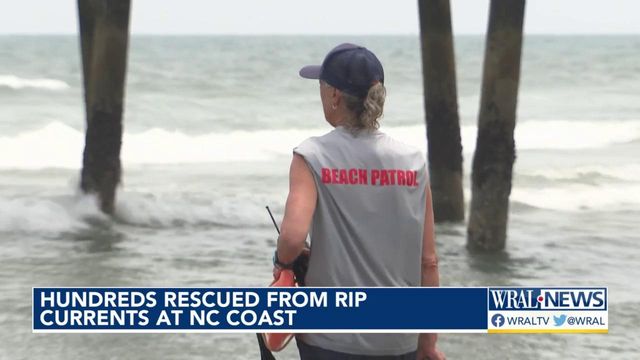Hundreds rescued over four days; rip current risk remains through the week
The National Weather Service reported 372 rip current rescues from July 1 through 4, but that number is probably low.
Posted — UpdatedThe North Carolina coast is averaging almost 100 people a day being rescued from rip currents over the long holiday weekend, and the threat remains through the coming week. According to the National Weather Service, there was a high risk of dangerous rip currents Tuesday along the Crystal Coast, in Onslow County and the Hatteras Island beaches.
At Wrightsville Beach, additional beach patrols have been in effect since Friday to keep visitors safe.
"On holiday weekends, we do ramp up coverage," said Sam Proffitt, Wrightsville Beach ocean rescue captain.
Some of that coverage included lifeguards, trained to spot a rip current when it forms and to keep swimmers away from danger.
"Lifeguards are trained to spot this," Proffitt said. "They will come out, and be proactive and tell you to move out of the area or even rescue you."
Over the holiday weekend, lifeguards rescued hundreds of people caught in rip currents up and down the North Carolina coast.
The National Weather Service reported 372 rip current rescues from July 1 through 4, but that number is probably low. It is based on phone calls to lifeguards who are, understandably, busy.
"We have had more rescues than normal – 19 to 20 a day – higher than so far this summer," Proffitt said.
The vast majority of rescues happened at Carolina Beach, which is popular with families, including those taking a day trip from the Triangle.
That continued a trend that began over the weekend. Saturday saw 88 water rescues on various beaches along the North Carolina and South Carolina coast. On Sunday, the beaches had a combined 124 water rescues.
Water rescues by beach, July 1-3, 2023
Carolina Beach: 61
Wrightsville Beach: 15
Kure Beach: 11
Carolina Beach: 72
Wrightsville Beach: 12
Kure Beach: 17
Carolina Beach: 70
Wrightsville Beach: 18
Kure Beach: 2
Carolina Beach: 25
Wrightsville Beach: 18
Kure Beach: 3
According to the National Weather Service, the most likely time for rip currents comes in the hours before or after low tide, which occurs Tuesday afternoon at 2:30 p.m.
Proffitt offered these tips:
- Don’t swim early in the morning or late in the afternoon
- Never swim near the pier or the jetty
- Never swim in or around inlets
Rip current safety tips
- Whenever possible, swim at a lifeguard-protected beach.
- Never swim alone.
- Learn how to swim in the surf. It's not the same as swimming in a pool or lake.
- Be cautious at all times, especially when swimming at unguarded beaches. If in doubt, don’t go out.
- Obey all instructions and orders from lifeguards. Lifeguards are trained to identify potential hazards. Ask a lifeguard about the conditions before entering the water. This is part of their job.
- Stay at least 100 feet away from piers and jetties. Permanent rip currents often exist along side these structures.
- Consider using polarized sunglasses when at the beach. They will help you to spot signatures of rip currents by cutting down glare and reflected sunlight off the ocean’s surface.
- Pay especially close attention to children and elderly when at the beach. Even in shallow water, wave action can cause loss of footing.
- Remain calm to conserve energy and think clearly.
- Never fight against the current.
- Think of it like a treadmill that cannot be turned off, which you need to step to the side of.
- Swim out of the current in a direction following the shoreline. When out of the current, swim at an angle – away from the current – toward shore.
- If you are unable to swim out of the rip current, float or calmly tread water. When out of the current, swim towards shore.
- If you are still unable to reach shore, draw attention to yourself by waving your arm and yelling for help.
- Don't become a victim, too.
- Get help from a lifeguard.
- If a lifeguard is not available, have someone call 911.
- Throw the rip current victim something that floats – a life jacket, a cooler, an inflatable ball.
- Yell instructions on how to escape.
- Remember, many people drown while trying to save someone else from a rip current.
Related Topics
• Credits
Copyright 2024 by Capitol Broadcasting Company. All rights reserved. This material may not be published, broadcast, rewritten or redistributed.






